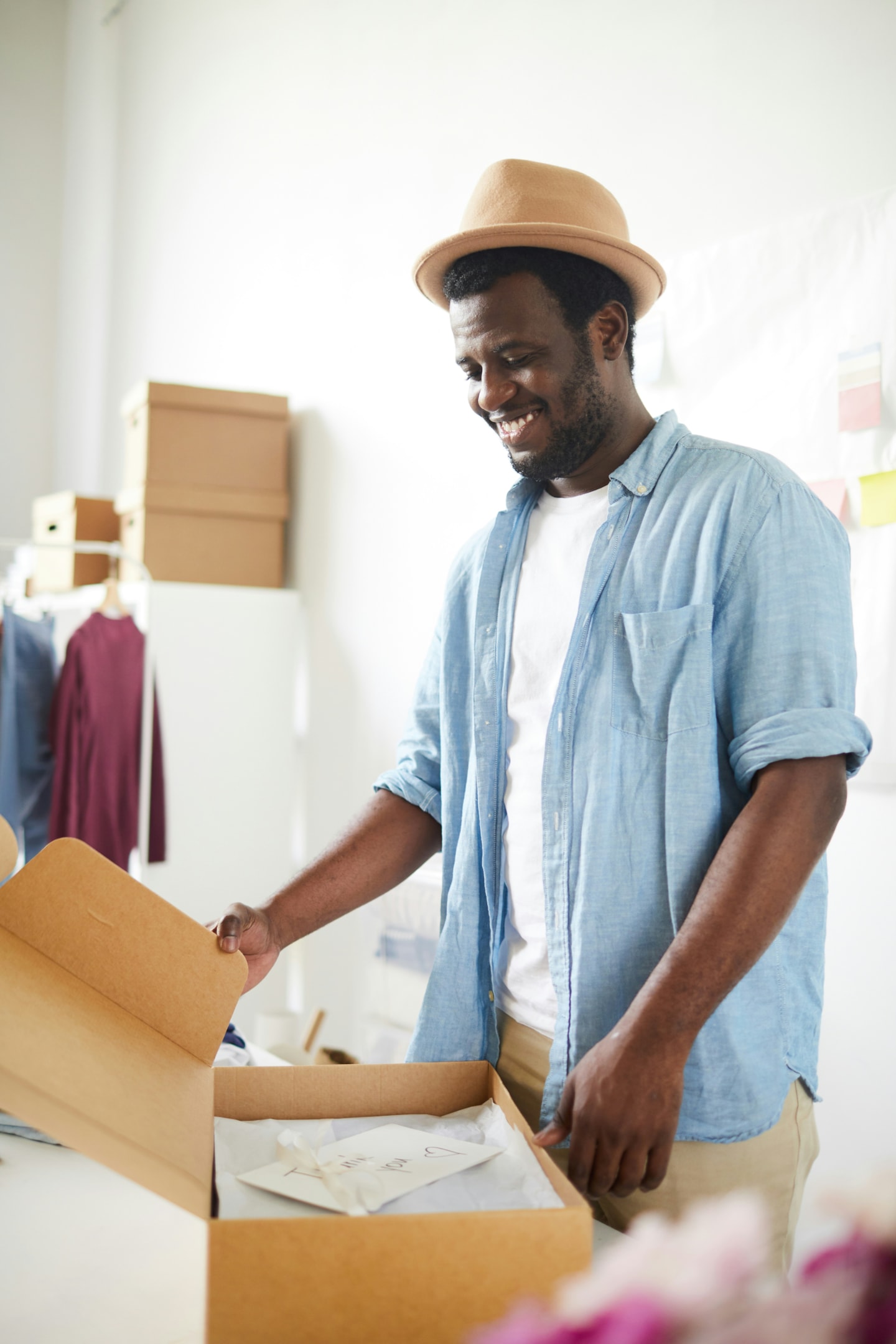How to grow an ecommerce business: From DIY fulfillment to scalable logistics
Picture this: You're a one-person powerhouse juggling product design, order fulfillment, marketing, and maybe even a full-time job. You're scrappy, strategic, and not afraid to get your hands dirty. Whether you're selling handmade beauty products, launching a sustainable apparel brand, or growing a CPG side hustle, you're doing it all from home.
Sound like you? Then this guide is for you.
If you're currently running an ecommerce business from your kitchen table, you're not alone. Most Saltbox members start with tape guns in one hand and Shopify alerts in the other, surrounded by product bins, bubble wrap, and very little elbow room. That hustle is real—but it shouldn't be your forever setup.
If you're dreaming of more space, more control, and more room to grow (literally and figuratively), you're in the right place. This step-by-step guide will walk you through how to scale your ecommerce operations and graduate into a professional workspace that works as hard as you do. Spoiler: Saltbox Access Plans are the not-so-secret weapon.
Recognize when you've outgrown your kitchen table

If you're still optimizing your current setup, check out our free Structuring Your Home Warehouse Journey guide. It offers practical layouts and tips to make your space work smarter until you're ready to scale. For many entrepreneurs like Amalia Falck, moving beyond the kitchen table (or in her case, her van) can feel like a big leap, but with the right guidance, it becomes a rewarding step toward growth.
🔧 Home setup graduation audit checklist
- Are you fulfilling more than 10 orders/day?
- Do you avoid marketing tasks because you're buried in fulfillment?
- Have you had to store product in your bedroom, garage, or living room?
- Are packages delayed or disorganized?
- Do you dread managing returns and restocks?
If you checked 3 or more, it's time to stop duct-taping your logistics and start scaling.
Still unsure if it's time to make a move? Here are five signs your business isn't ready for a warehouse lease—and what to do instead.
Amalia Falck of Come Alive Herbals remembers what it was like to run a business from a van. "Working and packing orders in my van, I faced so many challenges. Saltbox gave me the space and support to focus on what really matters: growing my business." Her story is proof that a shift in space can spark a shift in momentum.
Map your next move with space in mind

Moving from the kitchen table to a real workspace doesn't mean leasing a giant warehouse with overhead you can't afford. It means finding space that grows with you, and making sure resources and space are used efficiently as your online store scales.
That's where co-warehousing comes in. Co-warehousing solutions are designed for ecommerce founders like you who need:
- Flexible square footage (no bloated leases)
- On-site fulfillment support when you need it
- Loading docks, receiving services, and climate-controlled inventory storage
- A workspace you don't have to share with your toaster oven
As your business grows, choosing the right ecommerce platforms can help you scale operations and adapt seamlessly to new spaces.
Not every fulfillment setup gives you the peace of mind you deserve. Charlie Genry, Head of Operations at BiotiQuest, has seen firsthand how scalable Saltbox truly is. "We moved into our first suite with Saltbox in 2022 and have since grown into four suites. It's made the impossible possible." You don't need to sign a long-term lease to run a legit ecommerce business.
Curious what kind of space is right for you? Start with our post on whether you need a warehouse to run your ecommerce business.
Get scrappy with your setup

Once you've secured your new workspace, start treating your business like the big deal it is. There are many ways to optimize your setup for growth:
- Set up zones: Create dedicated areas for receiving, packing, inventory, and office work
- Automate your basics: Use apps like Parsel (Saltbox members get perks) to streamline shipping by using automation tools and processes
- Document your processes: Even if it's just you now, build for the day you bring on help—documenting and automating isn't just about efficiency, it's about helping your business scale and your team work better together
This phase is all about operational maturity. You're not just a founder anymore—you're a logistics boss.
Building for scale doesn't mean going big all at once. This blog breaks down how to create a logistics setup that grows with you.
🛠️ Bonus: The self-starter's small-but-mighty tech stack
- Shopify or WooCommerce for ecommerce management and building your online store or websites that are optimized for SEO and user experience
- Parsel for discounted, trackable shipping
- Airtable or Sortly for lightweight inventory tracking
- Barcode scanning apps like Orca Scan
- Canva for branded inserts and packaging
- Zapier for automating repetitive admin
- Social platforms (e.g., TikTok, Instagram, Facebook, YouTube) for marketing, brand visibility, and social commerce
- Paid ads and influencer marketing to expand reach, boost brand awareness, and drive engagement as part of your marketing tech stack
Tap into fulfillment support (you don't have to do it all)

The beauty of Saltbox Access Plans? You can hand off the stuff that drains your time without giving up control. For business owners, this means you can focus on growing your ecommerce business and driving more sales, while fulfillment support takes care of the logistics.
Mike Whitaker of PURioLABS has lived this evolution firsthand. “Getting a business off the ground and growing it are two very different challenges. Saltbox has helped us bridge that gap,” he said. The ability to tap into flexible fulfillment services without losing operational control made the difference between overwhelm and opportunity.
Access Plans give you the freedom to hand off fulfillment—without handing over your brand. See how they compare to traditional 3PLs.
How to build a brand that scales: Strategy moves beyond fulfillment
Build a strong ecommerce brand identity
In today's crowded ecommerce market, a strong brand identity is your secret weapon for standing out and winning over potential customers. For ecommerce businesses, building a memorable ecommerce brand isn't just about a catchy logo—it's about creating a story and experience that customers connect with and trust.
Start by defining what makes your business unique. What's your value proposition? Why should customers choose your products over the competition? Craft a compelling brand story that highlights your mission, values, and the journey behind your products. This narrative helps build brand awareness and makes your ecommerce business feel relatable and authentic.
Next, make sure your visual identity is consistent across every touchpoint. Invest in high-quality product descriptions and product pages that reflect your brand's personality. Your website should be easy to navigate, visually appealing, and aligned with your brand's voice. Every detail—from your color palette to your packaging—should reinforce who you are as a business.
By building a strong ecommerce identity, you'll not only attract new customers but also foster loyalty and trust, fueling long-term ecommerce growth. Remember: a great brand doesn't just sell products—it creates lasting relationships and helps your business grow.
Understand your target audience
The best way to grow your ecommerce business is to truly understand who you're selling to. Knowing your target audience allows you to create marketing strategies that actually resonate, improve customer service, and boost conversion rates.
Start by digging into market research. Who are your customers? What are their demographics, preferences, and shopping behaviors? Use customer feedback, social media campaigns, and website analytics to uncover what your audience really wants and needs. Pay attention to the questions they ask, the content they engage with, and the pain points they share.
Social media is a great way to connect directly with your target audience. Use platforms like Instagram, Facebook, or TikTok to engage in real conversations, share relevant content, and build brand awareness. The more you listen and interact, the better you'll understand your people—and the more effective your marketing strategies will become.
By putting in the work to know your audience, you can create personalized experiences, improve your marketing, and build a loyal customer base that drives ecommerce growth.
Create a customer-centric strategy
Putting your customer first is the foundation of every successful ecommerce business. A customer-centric strategy means making every decision with your customers' needs in mind—from the products you offer to the way you handle support.
Start by building strong relationships with your customers. Gather feedback through surveys, reviews, and direct communication, and use that data to inform your product development and marketing strategies. Exceptional customer service isn't just about solving problems—it's about making every customer feel valued and heard.
Consider implementing loyalty programs to reward repeat purchases, offering personalized recommendations based on browsing or purchase history, and providing fast, friendly support whenever your customers need it. These strategies not only increase customer satisfaction but also encourage repeat business and positive word-of-mouth.
By creating a seamless customer experience and always putting your customers first, you'll drive loyalty, boost growth, and set your ecommerce business apart from the competition.
Optimize your ecommerce store for growth
Your ecommerce store is your digital storefront—and optimizing it is key to driving growth and higher conversion rates. Start by making sure your website is user-friendly, fast, and mobile-ready. Platforms like Shopify make it easy to create a seamless shopping experience that keeps customers coming back.
Focus on your product pages: use high-quality images and videos, detailed product descriptions, and clear calls to action to help customers make confident purchasing decisions. Streamline your checkout process to reduce friction and cart abandonment, and offer secure payment options for peace of mind.
Don't forget about search engine optimization (SEO). By optimizing your website and product pages for relevant keywords, you'll improve your visibility in search results and attract more organic traffic. Fast shipping options and transparent return policies can further enhance the customer experience and increase average order value.
Upgrading your ecommerce store isn't just about looks—it's about creating a smooth, enjoyable journey that turns visitors into loyal customers and fuels your ecommerce growth.
Measure and analyze performance
To grow your ecommerce business, you need to know what's working—and what's not. Measuring and analyzing performance helps you make smarter, data-driven decisions that drive ecommerce growth.
Start by tracking key metrics like website traffic, conversion rates, average order value, and customer acquisition cost. Use tools like Google Analytics to monitor how customers find and interact with your site, and keep an eye on the effectiveness of your social media campaigns and email marketing efforts.
Regularly review your data to spot trends, identify bottlenecks, and uncover new opportunities. Are certain marketing strategies driving more sales? Is your website converting visitors into customers? Use these insights to refine your approach, improve customer satisfaction, and maximize your growth potential.
By focusing on the metrics that matter, you'll be able to adapt quickly, optimize your strategies, and ensure your ecommerce business is always moving forward.
It's time to level up your business
Saltbox Access Plans are built to help self-starters like you move from shipping chaos to calm, streamlined growth. Start with the space you need, use the services when you're ready, and scale with confidence.
With Saltbox Access Plans, you can expand into new markets and better serve your target market as your business grows. The best part? When you sign up you get a 30-day money-back gaurantee. It's that simple.
Because your living space deserves better—and so do you.
Frequently asked questions
What are the signs that my ecommerce business has outgrown a home setup?
If you're fulfilling more than 10 orders per day, avoiding marketing tasks due to fulfillment workload, storing products in living spaces, experiencing package delays or disorganization, or struggling with managing returns and restocks, these are clear signs it's time to move beyond your home setup.
How can co-warehousing help my ecommerce business grow?
Co-warehousing offers flexible workspace and fulfillment support without long-term leases. It provides access to loading docks, receiving services, climate-controlled inventory storage, and dedicated zones for receiving, packing, and office work, helping your business scale efficiently.
What technology tools can support ecommerce growth?
Tools like Shopify or WooCommerce for ecommerce management, discounted shipping apps like Parsel, inventory tracking software such as Airtable or Sortly, barcode scanning apps, design platforms like Canva, automation tools like Zapier, and social media platforms for marketing and social commerce can streamline operations and boost growth.
How do I create a strong ecommerce brand identity?
Start by defining your unique value proposition and crafting a compelling brand story. Ensure your visual identity is consistent across all touchpoints, including product pages, packaging, and your website. A strong brand builds trust, attracts new customers, and fosters loyalty.
Why is understanding my target audience important?
Knowing your target audience allows you to tailor marketing strategies, improve customer service, and increase conversion rates. Engaging with customers on social media and analyzing website analytics helps you understand their preferences and needs.
How can I optimize my ecommerce store for better growth?
Focus on making your website user-friendly, fast, and mobile-friendly. Use high-quality images and detailed product descriptions, streamline checkout to reduce cart abandonment, and optimize for search engines to attract organic traffic.
What key metrics should I track to measure ecommerce success?
Track website traffic, conversion rates, average order value, customer acquisition cost, and customer retention. Use tools like Google Analytics to monitor performance and refine your strategies based on data insights.
How can fulfillment support help me focus on growing my business?
Outsourcing fulfillment tasks through services like Saltbox Access Plans allows you to focus on marketing, product development, and customer engagement while ensuring efficient order processing and shipping.
For Her
For Him
For Pets
For Anyone

Related posts
Learn from businesses improving their operational efficiency. Explore how Saltbox’s expert support and flexible spaces drive their growth.


Black Friday ecommerce strategy: Complete 2025 guide to maximize holiday sales
Discover a comprehensive Black Friday ecommerce strategy for 2025 to maximize your holiday sales. Learn expert tips on technical optimization, targeted marketing, inventory planning, and customer retention to boost your online store’s performance during the busiest shopping season.


The ultimate small business holiday gift guide 2025
Every item in this guide comes from a Saltbox member. Thoughtfully made, ready to ship, and powered by small businesses.


Holiday shipping deadlines 2025: Complete guide for on-time delivery
This comprehensive guide covers every major carrier’s 2025 holiday shipping deadlines, from standard ground services to last-minute express options.







